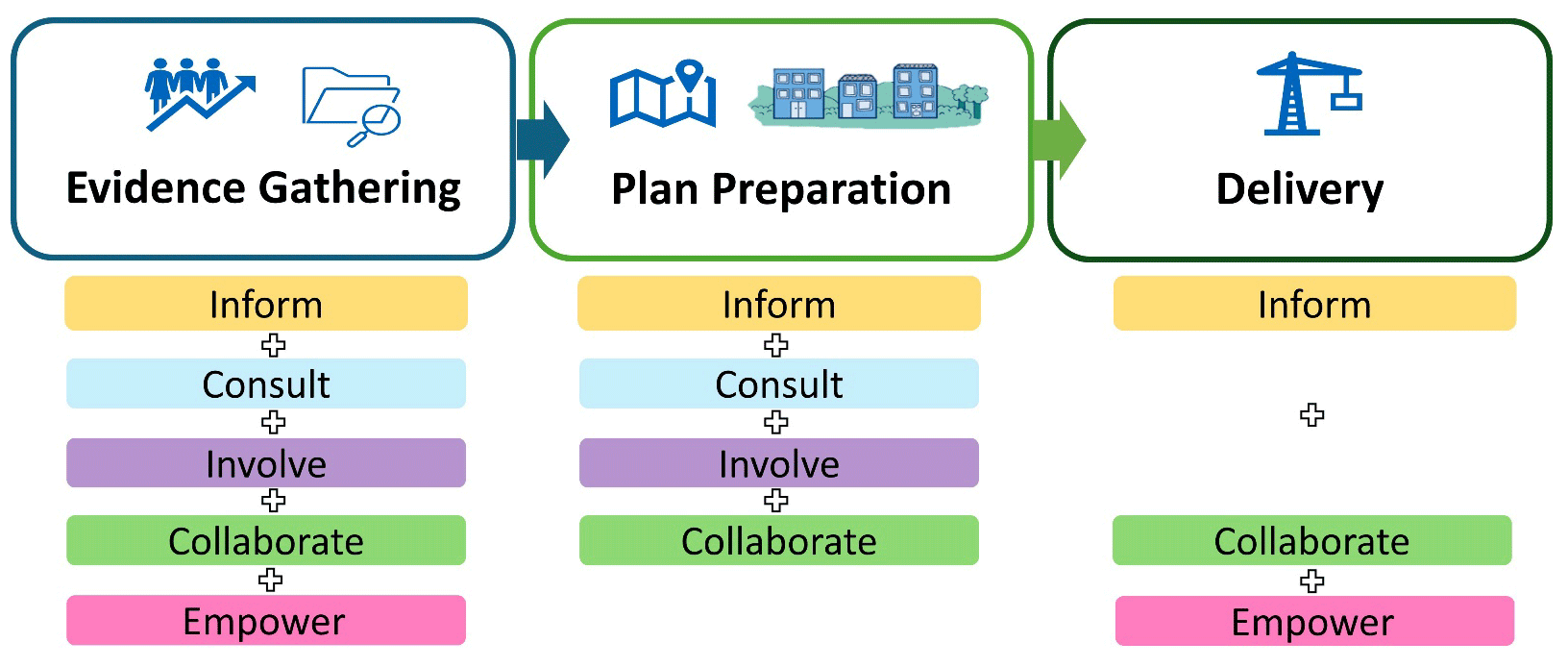Effective community engagement in local development planning: guidance
Guidance to assist with engagement activities in the preparation of local development plans. It is part of measures introduced by the Planning (Scotland) Act 2019 to put community voices at the heart of the planning system in Scotland.
2. Levels of engagement
This is a quick reference guide to the levels of engagement within the local development plan process. The structure will help planning authorities decide how and when to engage with communities and can help people and communities to understand when their effort will have most impact or influence in making Local Development Plans.
Being clear about the levels being used in engagement will help to manage expectations for everyone involved. Some levels of engagement will be more appropriate for some stages of the local development plan process than others. Planning authorities can tailor their approach to make the purpose of engagement clear at each stage.

Infographic description below:
Direction of power and influence for the Inform level:
- flows from the planning authority making the local development plan to the public/participants
- The planning authority will inform the public, providing objective information.
Direction of power and influence for the Consult level:
- flows from the public/participants to the planning authority making the local development plan
- The planning authority will consult with the public, to gain feedback on analysis, proposals and or/decisions.
Direction of power and influence for the Involve level:
- flows in both directions indicating direct work between both the planning authority making the local development plan and the public/participants
- ensuring issues and aspirations are directly considered
Direction of power and influence for the Collaborate/Collaborating level:
- flows in both directions indicating partnership working between the planning authority making the local development plan and the public/participants
- collaborative working to define issues, identify solutions and create alternatives
Direction of power and influence for the Empower/empowering level:
- flows in both directions indicating partnership working between the planning authority making the local development plan and the public/participants
- ensuring decision making and implementation reflects views and aspirations of the public/participants
These levels are informed by the Scottish Community Development Centre (SCDC) National Standards for Community Engagement and the International Association for Public Engagement Spectrum of Participation ((c) International Association for Public Participation www.iap2.org).
Level: Inform/Informing
Activity: to provide the public with objective information.
Planning authorities should:
- provide full, and clear information openly and transparently
- not withhold relevant information
- keep people informed.
Purpose and influence:
- to inform people with an interest in the outcome, including the public and interest groups.
Level: Consult/Consulting
Activity: to gain feedback on analysis, alternatives, proposals and/or decisions.
Planning authorities should:
- listen to and acknowledge issues and aspirations raised
- consider the contributions provided during engagement
- be open to influence through engagement
- provide feedback on how contributions and issues have influenced the outcome.
Purpose and influence:
- to inform people making proposals and those making decisions.
Level: Involve/Involving
Activity: to work directly with participants throughout the local development plan process to ensure issues and aspirations are consistently understood and considered.
Planning authorities should:
- work with people/communities to ensure their issues and aspirations are directly considered for how they may be reflected in outcomes, or alternatives created
- provide feedback on how inputs and issues have influenced the outcome, including where issues or aspirations may not have been incorporated.
Purpose and influence:
- allow participants to directly influence the decisions/options that are considered
- help them understand why some issues and aspirations may not have been incorporated.
Level: Collaborate/Collaborating
Activity: to partner with participants to define issues, identify solutions, and create alternatives.
Planning authorities should:
- seek advice and innovation from communities and partners in creating solutions
- in so far as possible, incorporate the advice and recommendations from partners into decisions and implementation
Purpose and influence:
- to help create more equal partnerships
- sharing the creation and decision making processes as much as possible, recognising the legal role of the planning authority and the knowledge of communities about their place.
Level: Empower/Empowering
Activity: to ensure decision making and implementation reflects the views and aspirations of participants to the maximum extent possible.
Planning authorities should:
- allow participants to decide to the maximum extent possible, whilst respecting the legal framework for preparing Local Development Plans and duties on planning authorities.
Purpose and influence:
- to give people the power, where appropriate, to make decisions around elements of the local development plan making process, respecting the legal framework and duties on planning authorities to lead on preparation of Local Development Plans.
- give people the power to take action to implement the local development plan vision.
Contact
Email: chief.planner@gov.scot
There is a problem
Thanks for your feedback